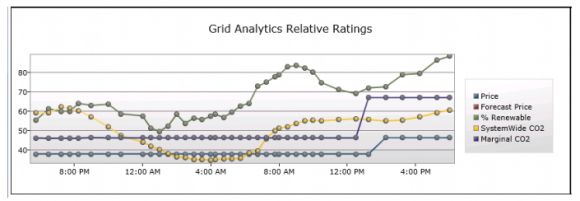There are a lot of ways to enable intelligent efficiency and procure more renewables for energy-intensive data centers.
If you're an internet giant like Apple, Facebook or Google, you could simply invest tens of millions in state-of-the-art facilities.
If you're a smaller operator (like most) looking for lower-cost alternatives, using energy management software to dynamically control cooling and reduce on-site load is one option. Another is to buy carbon offsets, renewable energy credits, or enter into direct power purchase agreements for clean electricity.
And then there's simple math.
Microsoft has just published a new paper outlining two algorithms that could help data center operators predict the cheapest and cleanest times on the grid for intensive computation. The models could enable demand response for computing that would allow customers to shift behavior based on grid conditions.
For some data center operators, the graph below showing the peaks and valleys of renewable generation (almost entirely wind) on Ireland's grid might cause headaches.

Indeed, Microsoft's analysis of Ireland's deregulated electricity market for the first quarter of 2012 found that spot prices shot up to 985 percent above the average price, that marginal emissions changed by 55 percent, and that renewable electricity generation varied by nearly 12 percent. When renewable penetration was highest, market prices "reduced significantly," concluded the researchers.
To Microsoft, these peaks and valleys are an opportunity, not a worry.
"The properties of renewable generation...make it very useful for flexible energy consumers. They essentially provide windows of low-cost, low-emissions electricity, which in turn allows a business running from this source to provide low-cost, low-emissions products or services," wrote the researchers in a report on their findings.
The Microsoft researchers, based in Dublin, Ireland, developed two algorithms to help predict when the highest point of renewable energy generation may occur or when electricity prices are lowest (in Ireland, those two periods often coincide). Grid operators or data center owners could use those algorithms to create pricing structures that encourage customers to move their most energy-intensive operations to these periods.
"Performing computation at these 'good' times could greatly increase the mix of renewable energy, achieve up to a 99% reduction in CO2 emissions, or decrease the energy costs for the same piece of computation depending on what the customer or operator priorities are," explained Fabien Petitcolas, Microsoft's director for innovation in Europe in a blog post about the research.
The first algorithm, called "relative rating analytics," plugs in a variety of customer preferences such as emissions reductions, lower computing costs, or boosts in server utilization. These factors are all weighted by importance, compared against historic values, and assigned a current relative rating. Microsoft's data mining and analytics then pops out a grid visualization that looks like this:

The second algorithm, called "cost plus margin," creates a pricing structure for computing services that accounts for fixed costs at a data center, required profit margin, and changing factors within the variable energy markets. This insulates data center operators from spikes in energy prices or rising carbon prices, while also giving users the flexibility to move their computing to optimum times.
These two models could provide new opportunities for granular computational demand response, allowing providers of cloud services to adjust their needs in real time based on energy conditions.
"Data center operators could use the methods outlined in this research to add to the momentum of renewable energy adoption and the drive towards carbon-free electricity sources," wrote Microsoft's Fabien Petitcolas.
And they could potentially do it without massive equipment upgrades or direct investments in renewable energy projects.
There's one massive caveat, however.
"It should be noted that the long-term impact of a dynamic price on the demand of such a cloud service has not been studied in a real-world situation," concluded the Microsoft researchers.



